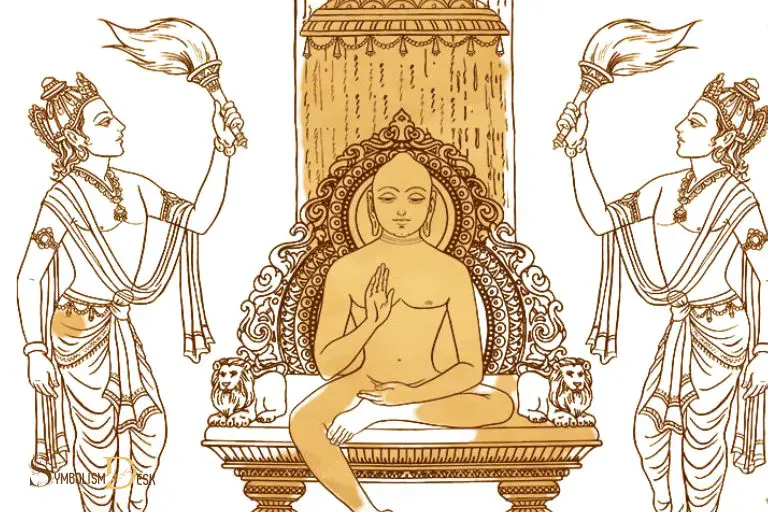24 Tirthankar Names With Symbols: Complete List!
The 24 Tirthankaras in Jainism are spiritual teachers who represent the path to spiritual liberation. Each Tirthankara has a unique name and symbol, symbolizing their teachings and attributes.
Tirthankaras are highly revered spiritual figures in Jainism, who have attained spiritual enlightenment and serve as role models for those seeking spiritual growth.
Jainism believes in a cyclical universe, and every half-cycle has a set of 24 Tirthankaras to guide the beings towards liberation.
24 Tirthankar Names With Symbols Chart
| Tirthankar | Name | Symbol |
|---|---|---|
| 1 | Rishabhanatha | Bull |
| 2 | Ajitanatha | Elephant |
| 3 | Sambhavanatha | Horse |
| 4 | Abhinandananatha | Ape |
| 5 | Sumatinatha | Heron |
| 6 | Padmaprabha | Lotus |
| 7 | Suparshvanatha | Swastika |
| 8 | Chandraprabha | Moon |
| 9 | Pushpadanta | Crocodile |
| 10 | Sheetalanatha | Kalpavriksha |
| 11 | Shreyansanatha | Rhinoceros |
| 12 | Vasupujya | Buffalo |
| 13 | Vimalanatha | Boar |
| 14 | Anantanatha | Falcon |
| 15 | Dharmanatha | Vajra |
| 16 | Shantinatha | Deer |
| 17 | Kunthunatha | Goat |
| 18 | Aranatha | Fish |
| 19 | Mallinatha | Water jug |
| 20 | Munisuvratanatha | Tortoise |
| 21 | Naminatha | Blue lotus |
| 22 | Neminatha | Shankha |
| 23 | Parshvanatha | Snake |
| 24 | Mahavira | Lion |
Key Takeaway

Five Facts About Tirthankar Names With Symbols
What Are Tirthankars And Their Importance In Jainism?
Definition Of Tirthankars
Tirthankars are enlightened beings in jainism, who have attained liberation and removed all karma from their soul.
They are considered as the role models for the followers of jainism. The word “tirthankar” means “one who has conquered the cycle of birth and death.
Significance Of Tirthankars In Jainism
Jainism believes in non-violence, non-attachment, and non-possession, among other principles.
Tirthankars’ teachings emphasize these values and provide a path for followers to achieve liberation, which is the ultimate goal in jainism. The tirthankars also serve as a source of inspiration and guidance for the practitioners of jainism.
Brief History Of Tirthankars In Jainism
According to jainism, the universe is infinite and eternal, and there have been countless tirthankars before the current era.
Each tirthankar comes in a specific time period and has a specific set of teachings that become relevant for that era.
The most recent tirthankar was lord mahavir, who lived around 2500 years ago. He established the foundation of jainism and his teachings have been passed down through generations.
- The 24 tirthankars are revered in jainism for their teachings, which emphasize non-violence, non-possession, and non-attachment.
- Tirthankars played a significant role in establishing jainism and providing guidance to its followers.
- Jainism believes in the concept of karma, and tirthankars’ teachings provide a path to remove karma and attain liberation.
- The most recent tirthankar was lord mahavir, who lived around 2500 years ago and established jainism’s foundational principles.
List Of 24 Tirthankars And Their Symbols
The concept of tirthankar or a jain spiritual guide is highly venerated in jainism. These beings have attained enlightenment and embodied a perfect understanding of the jain philosophy.
Each tirthankar has their own unique symbol that symbolizes their spiritual journey.
Here is a list of 24 tirthankars and their symbols.
Rishabhdev And His Symbol
- Rishabhdev is the first tirthankar and the father of the human race.
- The symbol associated with him is the bull, symbolizing spiritual power and stability.
Ajitnath And His Symbol
- Ajitnath is the second tirthankar.
- The symbol associated with him is the elephant, symbolizing purity and strength.
Sambhavnath And His Symbol
- Sambhavnath is the third tirthankar.
- The symbol associated with him is the horse, symbolizing grace and beauty.
Abhinandan Swami And His Symbol
- Abhinandan swami is the fourth tirthankar.
- The symbol associated with him is the monkey, symbolizing intelligence and agility.
Sumatinath And His Symbol
- Sumatinath is the fifth tirthankar.
- The symbol associated with him is the conch, symbolizing the sound of truth.
Padmaprabhu And His Symbol
- Padmaprabhu is the sixth tirthankar.
- The symbol associated with him is the lotus, symbolizing spiritual enlightenment.
Suparshvanath And His Symbol
- Suparshvanath is the seventh tirthankar.
- The symbol associated with him is the swastika, symbolizing good fortune and prosperity.
Chandraprabhu And His Symbol
- Chandraprabhu is the eighth tirthankar.
- The symbol associated with him is the crescent moon, symbolizing peace and tranquility.
Suvidhinath And His Symbol
- Suvidhinath is the ninth tirthankar.
- The symbol associated with him is the buffalo, symbolizing stability and strength.
Shitalnath And His Symbol
- Shitalnath is the tenth tirthankar.
- The symbol associated with him is the kalash, a holy urn symbolizing purity and peace.
Shreyansanath And His Symbol
- Shreyansanath is the eleventh tirthankar.
- The symbol associated with him is the rhinoceros, symbolizing courage and strength.
Vasupujya Swami And His Symbol
- Vasupujya swami is the twelfth tirthankar.
- The symbol associated with him is the male deer, symbolizing tranquility and kindness.
Vimalnath And His Symbol
- Vimalnath is the thirteenth tirthankar.
- The symbol associated with him is the boar, symbolizing protection and courage.
Anantnath And His Symbol
- Anantnath is the fourteenth tirthankar.
- The symbol associated with him is the porcupine, symbolizing self-defense and detachment.
Dharmanath And His Symbol
- Dharmanath is the fifteenth tirthankar.
- The symbol associated with him is the thunderbolt, symbolizing the power of pure consciousness.
Shantinath And His Symbol
- Shantinath is the sixteenth tirthankar.
- The symbol associated with him is the antelope, symbolizing beauty and grace.
Kunthunath And His Symbol
- Kunthunath is the seventeenth tirthankar.
- The symbol associated with him is the goat, symbolizing humility and obedience.
Aranath And His Symbol
- Aranath is the eighteenth tirthankar.
- The symbol associated with him is the fish, symbolizing knowledge and creativity.
Mallinath And His Symbol
- Mallinath is the nineteenth tirthankar.
- The symbol associated with him is the jar, a container symbolizing endurance and perseverance.
Munisuvrata Swami And His Symbol
- Munisuvrata swami is the twentieth tirthankar.
- The symbol associated with him is the tortoise, symbolizing longevity and steadfastness.
Naminath And His Symbol
- Naminath is the twenty-first tirthankar.
- The symbol associated with him is the blue lotus, symbolizing purity and enlightenment.
Neminath And His Symbol
- Neminath is the twenty-second tirthankar.
- The symbol associated with him is the shankh, symbolizing the divine sound of the universe.
Parshvanath And His Symbol
- Parshvanath is the twenty-third tirthankar.
- The symbol associated with him is the snake, symbolizing rejuvenation and rebirth.
Mahavir Swami And His Symbol
- Mahavir swami is the twenty-fourth and last tirthankar.
- The symbol associated with him is the lion, symbolizing the power and strength of dharma.
Each tirthankar symbolizes something unique and represents a significant position in jainism. Understanding their symbols helps in understanding the jain philosophy better.
Symbolism In Tirthankar’S Names And Symbols
In jainism, the tirthankars are highly revered figures, considered as enlightened souls who have attained liberation from the cycles of birth and death.
The names and symbols associated with these tirthankars hold great significance, and understanding them can help us understand jain philosophy better.
Let’s take a closer look at the symbolism in tirthankar’s names and symbols.
Significance Of The Symbols And Names Of Tirthankars
- Each tirthankar has a unique symbol and name that represents their teachings and characteristics.
- The symbols and names of tirthankars are meant to remind us of their virtues and inspire us to follow their path.
- The symbols and names also help in distinguishing one tirthankar from the other and aid in meditation.
Spiritual Symbolism Associated With Tirthankar’S Names And Symbols
- The names of tirthankars have spiritual connotations and embody their virtues and qualities.
- The symbols associated with tirthankars depict different aspects of their teachings and philosophy.
- The lotus symbolizes purity and detachment, the swastika symbolizes good luck and positivity, while the lion symbolizes strength and courage.
Understanding The Deeper Meaning Of The Symbols And Names Of Tirthankars
- The names of tirthankars are derived from the language of their time and signify their soul’s eternal nature.
- The symbols associated with tirthankars represent their spiritual achievements and the qualities they possessed.
- Understanding the symbolism behind the names and symbols of tirthankars can help us gain a deeper insight into jain philosophy and cultivate the virtues embodied by them.
The names and symbols of tirthankars hold profound spiritual significance and offer valuable teachings on how to lead a virtuous life.
Understanding their symbolism can aid us in our spiritual journey and help us become better human beings.
Tirthankars And Their Relevance In Modern Times
The jain community regards tirthankars as their spiritual leaders who have liberated themselves from the cycle of birth and death.
According to jainism, there are 24 tirthankars. Each has a unique symbol and an exceptional contribution to the religion’s teachings. The first tirthankar, Rishabhanatha, is symbolized by a bull and is known for establishing the basic principles of Jainism. The twenty-third tirthankar, Parshvanatha, is represented by a snake and is attributed with formalizing the Jain monastic community. The 24th and final tirthankar, Mahavira, is depicted with a lion symbol and is recognized for his role in codifying and spreading the religion’s doctrines. Anjali mudra meaning “gesture of respect and greeting” is often associated with the worship and reverence of these tirthankars in Jainism.
In modern times, understanding the relevance of the tirthankars can benefit us in many ways.
How Understanding The Tirthankars Can Benefit Us In Modern Times
- By studying the life of tirthankars, we can gain knowledge about jain principles and learn to apply them in our daily lives.
- In today’s hectic lifestyle, the lessons taught by tirthankars, like non-violence, truthfulness, and non-attachment can help reduce stress and mental health issues.
- Tirthankars prioritized self-discipline and self-control. Learning about their teachings can help individuals become more self-aware and achieve a sense of inner peace.
- Additionally, by understanding the teachings of tirthankars, individuals can become more compassionate towards all living beings and practice environmental sustainability.
The Importance Of Tirthankars In Promoting Spiritual And Moral Values
- Tirthankars are keystones of jainism, and their teachings focus on living a simple and spiritual life.
- Their teachings emphasize the importance of non-violence, which is critical, especially in today’s world where incidents of violence are prevalent worldwide.
- Humans have a duty to lead a moral life and avoid sins. Tirthankars advocate the importance of moral values like honesty, non-stealing, and celibacy.
- Tirthankars teach us to avoid attachments, which can lead to unnecessary suffering. By practicing non-attachment, we can become free from stress and anxiety and lead a meaningful life.
How To Incorporate The Teachings Of Tirthankars In Our Daily Lives
- Non-violence is one essential teaching of tirthankars. We can practice non-violence by avoiding harm to all living beings, including insects and animals.
- Tirthankars promote a life of simplicity. We can practice simplicity by avoiding wasteful expenditure and living sustainably.
- Self-discipline is critical in life. By practicing self-discipline, we can control our mind and body, leading to a peaceful mind and soul.
- Lastly, tirthankars advocate the significance of forgiveness. Practicing forgiveness and letting go of negative emotions can lead to a peaceful and content life.
Learning about the tirthankars and their teachings can have significant benefits for us in modern times.
By incorporating their teachings into our daily lives, we can lead fulfilling lives, both spiritually and morally.
Do Political Party Symbols Have any Significance or Meaning?
Political party symbols have long been used as visual representations of political ideologies and beliefs. These symbols serve as powerful tools to capture the attention and loyalty of voters. From the Democratic donkey to the Republican elephant, political party symbols on the political party symbols list hold significant meaning and play a crucial role in shaping public perception and fostering party identification.
FAQ For 24 Tirthankar Names With Symbols
What Are The 24 Tirthankar Names?
The 24 tirthankar names are the names of the spiritual leaders in jainism.
What Are The Symbols Associated With Each Tirthankar?
Each tirthankar is associated with a unique symbol such as lotus, fish, conch, etc.
Why Are These Symbols Important In Jainism?
These symbols represent special qualities and attributes of each tirthankar that can inspire followers.
How Are The Tirthankar Names And Symbols Significant In Jainism?
The tirthankar names and symbols are an important part of jainism’s rich history and cultural heritage.
How Can This Knowledge Of Tirthankar Names And Symbols Benefit Us In Everyday Life?
Learning about the tirthankar names and symbols can help us gain a deeper understanding of jainism and its values.
Conclusion
As we conclude our exploration into the 24 tirthankar names with symbols, it is evident that jainism has a rich history that deserves to be celebrated. The tirthankars hold great significance in the jain community and are revered for their teachings, principles, and virtues.
Additionally, their names and symbols serve as reminders of their contributions to jainism and inspire followers to emulate their path. It is fascinating to note the intricate details behind the selection of each symbol and the significance it holds.
It is important to continue to preserve this legacy and ensure the knowledge and reverence for the tirthankars is passed down from generation to generation.
As we end our journey, let us take with us a newfound appreciation for the tirthankars and the symbolism behind their names, inspiring us to lead a life of virtue and righteousness.






